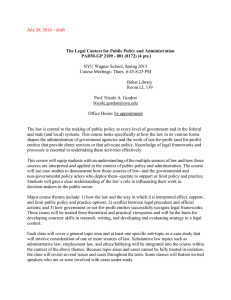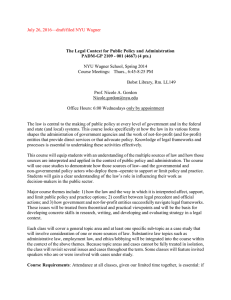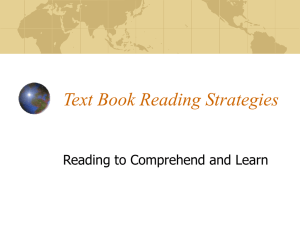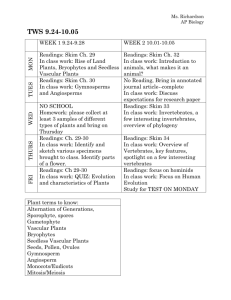July 26, 2016—draft NYU Wagner School, Spring 2012
advertisement
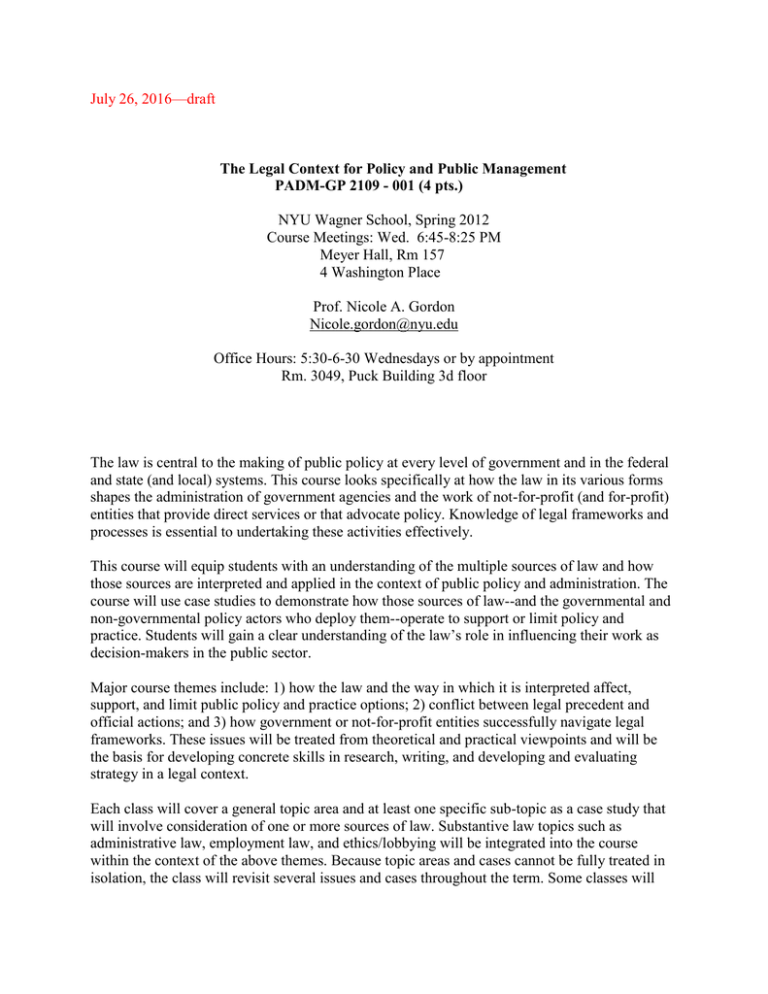
July 26, 2016—draft The Legal Context for Policy and Public Management PADM-GP 2109 - 001 (4 pts.) NYU Wagner School, Spring 2012 Course Meetings: Wed. 6:45-8:25 PM Meyer Hall, Rm 157 4 Washington Place Prof. Nicole A. Gordon Nicole.gordon@nyu.edu Office Hours: 5:30-6-30 Wednesdays or by appointment Rm. 3049, Puck Building 3d floor The law is central to the making of public policy at every level of government and in the federal and state (and local) systems. This course looks specifically at how the law in its various forms shapes the administration of government agencies and the work of not-for-profit (and for-profit) entities that provide direct services or that advocate policy. Knowledge of legal frameworks and processes is essential to undertaking these activities effectively. This course will equip students with an understanding of the multiple sources of law and how those sources are interpreted and applied in the context of public policy and administration. The course will use case studies to demonstrate how those sources of law--and the governmental and non-governmental policy actors who deploy them--operate to support or limit policy and practice. Students will gain a clear understanding of the law’s role in influencing their work as decision-makers in the public sector. Major course themes include: 1) how the law and the way in which it is interpreted affect, support, and limit public policy and practice options; 2) conflict between legal precedent and official actions; and 3) how government or not-for-profit entities successfully navigate legal frameworks. These issues will be treated from theoretical and practical viewpoints and will be the basis for developing concrete skills in research, writing, and developing and evaluating strategy in a legal context. Each class will cover a general topic area and at least one specific sub-topic as a case study that will involve consideration of one or more sources of law. Substantive law topics such as administrative law, employment law, and ethics/lobbying will be integrated into the course within the context of the above themes. Because topic areas and cases cannot be fully treated in isolation, the class will revisit several issues and cases throughout the term. Some classes will feature invited speakers who are or were involved with cases under study. Course Requirements: Attendance at all classes, given our limited time together, is essential: if you must be absent, let me know in advance. Class participation is important to your performance in the class. Grading is as follows: two short papers (50%); class participation (20%), and a final exam (30%). You will have the option to write a third paper that will not be counted towards your grade (unless it helps you!) in a manner that I will have explained in class. Please arrive in class prepared to discuss the questions set forth in the class summaries, the readings, case studies, and other pre-class assignments as indicated. You should also do some research in advance of class into the case studies that are newsworthy for contemporary media coverage. For papers, please be sure to present your thinking in clear, concise, precise, grammatical writing. Late Assignment Policy: Your short paper assignments are indicated at various weeks on the syllabus below. Note that papers are due by hand at the beginning of class or ONE HOUR before class starts for that week, sent to me as a Word Document attachment (please maintain compatibility with Word 1997-2003 i.e., no “docx”). Extensions will be granted only in case of emergency, out of respect to those who abide by deadlines despite equally hectic schedules. Late submissions without extensions will be penalized ½ letter grade per day (e.g., B+ to B). Course Readings: All readings will be posted on Blackboard. Students with disabilities: Any students requiring accommodations should be in contact with me to make proper arrangements. Please be prepared to submit your documentation from the NYU disabilities office regarding appropriate accommodations. 2 Class # 1, Jan. 25 Introduction to Sources of Law What are the principal sources of law, how do they come into existence, and how are they amended? What is the authority for these sources and what precedence does one source enjoy over another? What are the basic rules of interpretation? What is the “common” law? How does it overlap with or inform our understanding of statutory and constitutional sources? What is the intersection between these sources of law and public policy and administration? Who makes policy in a legal context? How do the three branches of government respond when legal ambiguities leave policy resolution in doubt? When can/should the courts or administrative agencies intervene if constitutional and statutory sources of the law are unclear or silent? When does legal process determine results? What does it mean to be results-oriented or processoriented? We will begin exploring these questions, in part by examining the recent New York State case of Governor Paterson’s appointment of Richard Ravitch as Lieutenant Governor as a starting point. Key discussion topic: understanding the multiple (public and private) sources of law and how they are applied in situations implicating all three branches of government. Readings: “Sources of Law & Their Hierarchy” (from Burnham, Introduction to the Law and Legal System, Chapt. II, pp.37-47) Skelos, et al. v. Paterson, et al. (New York State Court of Appeals) Richard Briffault, “Skelos v. Paterson: The Surprisingly Strong Case for the Governor’s Surprising Power to Appoint a Lieutenant Governor”, 73 Alb. L. Rev. 675 (2010) James A. Gardner, “New York's Inbred Judiciary: Pathologies of Nomination and Appointment of Court of Appeals Judges” (May 10, 2010). 58 Buffalo Law Review 15 (2010) (page 24 fn. 26 only) Classes ## 2-3, Feb. 1, 8 Constitutional Interpretation: Close Reading of the Text The U.S. and State Constitutions are not comprehensive, and may not always be the last authority. For example, both the U.S. and New York State Constitutions are ambiguous or silent on areas relating to succession in the case of death or inability of the chief executive. How are we to read and interpret these basic documents? We will study how the challenging legal and practical problems of succession have been resolved in crisis situations, in part through continued discussion of the Paterson-Ravitch appointment. Readings: “Sources of Law & Their Hierarchy” (from Burnham, Introduction to the Law and Legal System, Chapt. II, pp.54-61 and skim to top of 67) (this document is on Blackboard under Class # 1) U.S. Constitution Art. II and Amendment XXV Draft of Art. II as submitted to Committee on Style in 1788 and Draft of Art. II as submitted to the Convention by the Committee on Style 3 John D. Feerick, The Twenty-Fifth Amendment: Its Complete History and Applications (1992) at pp. 5-23 Second Report of the Continuity of Government Commission, Presidential Succession (June 2009) New York State Constitution, Art. IV, sections 5, 6 and Art. XII New York State Public Officers Law Sections 41, 42, 43 [Fordham Law paper if available TBD] Sub-topic(s): Presidential (and Gubernatorial) Succession. How have ambiguous U.S. and New York State constitutional provisions been interpreted? Did Presidents Tyler and Lyndon Johnson serve out Presidential terms in contravention of the U.S. Constitution? Confirmed Speaker (Feb. 1): Peter J. Kiernan, Counsel to former Gov. Paterson Pre-Class Assignment for Class # 2: Write a 2-page paper discussing whether you agree with the conclusion in Skelos v. Paterson (4-3 decision) as a matter of law and why. Or write a 2-page paper on the constitutional validity of Tyler’s or Johnson’s (your choice) service of the full remaining term of office as President of the United States. (Optional.) Class # 4, Feb. 15, Legislative Sources, Conflicts in Statutory Interpretation, and the Politics of Resolving Conflicts Statutes are interpreted through many avenues, such as by examining the plain language of the text, the purpose of the statute, and legislative history. We will study a statute that generated conflicting interpretations within New York City government over the lawful amount of public funds due to candidates for public office after the City Charter was amended by adoption of a Charter Revision ballot proposal. Reading(s): New York City Campaign Finance Board, Ballot Issues Voter Guide, November 3, 1998, Section on Possible Ballot Proposal: Charter Revision Commission’s Proposal on Campaign Finance Reform, pp. 14 & ff. NYC Admin. Code Sections 3-701, et seq. (selected sections, especially Section 3-703) New York City Campaign Finance Board post-election report, “An Election Interrupted…”, Sept. 2002 pp. 2-6 NYC Local Law No. 21 of 2001 Malbin and Brusoe, “Campaign Finance Policy in the State and City of New York” (2010) Malbin and Brusoe, “Small Donors Big Democracy” (2011) NYCCFB Advisory Opinion re: 4-1 matching Charter Revision letter from NYC CFB 4 New York Times and Daily News articles on 4-1 matching [Opinion of Attorney General Robert Abrams in letter to Edward I. Koch, re: power of NYC to enact campaign finance legislation, Oct. 21, 1987 ] Sub topic(s): Did the New York City Charter of 1998 contemplate a $4-$1 or a $1-$1 public funds match for contributions to candidates in the New York City Campaign Finance Program? How was the conflict between the NYC Campaign Finance Board’s interpretation of the statute and that of the Mayor’s office resolved? What are public policy arguments in favor of public matching funds programs? Pre-Class Assignment: Perform independent research (in addition to the readings) on the models of public campaign finance programs: full, matching, hybrid and familiarize yourself with the issues raised by the Supreme Court’s decision in Citizens United with respect to public financing of campaigns and the constitutional rights of corporations. Be prepared to give sources for the information you rely upon. Class #5, Feb. 22 Law, Politics, & Pragmatism: The Case of the Brooklyn Museum Taxpayer money often goes to causes that are not supported by individual elected officials or by members of the voting public. We will examine controversial cases in which conflicts over the proper use of public money was at issue. When New York City attempted to withdraw taxpayer funding from a respected museum that mounted an art exhibit that some deemed offensive, a lawsuit ensued, and ultimately the matter was resolved by a settlement. As we will study in detail, each side had arguably defensible moral/political positions, but the law and policy bases for those positions were not as clear. Readings 14-20) Brooklyn Institute of Arts and Sciences v. Rudolph W. Giuliani (You may skip pp. Photographs and articles on the “Sensation” exhibit Philippe de Montebello NY Times op. ed. on this topic (2001) Briefs in the Brooklyn Institute case: a) Brief of the City of New York pp. 1-16; [34-45]; 45-59 b) Brief of Brooklyn Institute of Arts and Sciences pp. 1-21, 40-56 [57-60], 6163 [Floyd Abrams, Speaking Freely (Chapter on Brooklyn Institute case)—optional] Sub-topic(s): The development of case law as distinct from statutory enactments. Confirmed Outside Speaker: Len Koerner, Chief of Appeals Division, NYC Corporation Counsel (argued the Brooklyn Institute case) 5 Pre-Class Assignment: Study a recent controversy (such as the MTA’s distribution in subway system of anti-mosque advertisements), and write a 2-page opinion as the Corporation Counsel advising the Mayor on the best position to take. (Optional.) Class # 6, February 29 Executive and Agency Sources of Law Public law relies heavily on agency rules and regulations, as well as practices. How are these developed? What does “Notice and an Opportunity to Comment” on proposed rules require? What discretion does an agency have in interpreting the laws it implements and what deference is owed to an agency’s interpretation? How “creative” can an agency be in establishing administrative law—e.g., what is the difference between an agency’s mandate and its powers? How can an agency make law outside of its rule-making authority? We will continue the study of statutory interpretation by examining issues in health law, such as recent federal food safety legislation, posting of calorie counts in restaurants, posting of cigarette warnings, or use of environmental impact regulations as a means to address lead poisoning in children. Readings: Summary of cases related to asylum for victims of female genital mutilation (undated) Asylum statute: Immigration and Nationality Act Section 241(b)(3)(A), 8 U.S.C. Section 1231(b)(3)(A) (2006) Asylum regulation: 8 C.F.R. Section 1208.16(b)(A)(i) Matter of Kasinga, BIA June 13, 1996 Matter of A.K. BIA, Sept. 5 2007 Matter of A-T BIA, Sept. 27 2007 Matter of Bah (Court of Appeals for the 2d Circuit), June 11, 1998 Matter of A-T, decided by Attorney General Mukasey, U.S. DOJ, Sept. 22, 2008 Equality Now, “Action Alert” April 29 2010 Lisa M. Koenig and Archana Pyati, “Litigation in Landmark Asylum Case Over Domestic Violence Resumes” New York Law Journal, June 24, 2009 Sub-topic(s): The changing interpretation of adequate basis for asylum status under immigration law in the case of female genital mutilation; Administrative Law[; Securities regulation section 10b-5 (example of administrative regulation that became more influential than the ‘governing’ statute)] Class # 7, March 7 Legal Process: How Public Interest Groups Have Made Use of Courts’ Direct Power over Compliance As a result of challenges by public interest organizations to government practices, courts have sometimes taken on substantial responsibilities for government operations: e.g., they have 6 effectively governed complex institutions like prisons and school systems. How far can/should courts go to oversee programs that have been found to be out of compliance with the law? Readings: Abram Chayes, “The Role of the Judge in Public Law Litigation,” 89 Harv. L. Rev. 1281 (1976) pp. 1298-1302, 1305-1309 Morris E. Lasker, "Prison Reform Revisited: A Judge's Perspective" (2004), Pace Law Review. Paper 3 (re: NYC prisons consent decree) Koerner, “Institutional Reform Litigation”, 53 New York Law School Law Review 509 (2008/09) Boston v. NYC Consent Decree Callahan v. Carey Consent Decree Sub-topic(s): How public interest groups have relied upon the terms of consent decrees to accomplish policy objectives. When/why government enters into consent decrees. Invited Speaker: Steve Banks, Attorney-in-Chief, The Legal Aid Society Class # 8, March 21 Review; Conflicts Among Sources of Law and Branches of Government: What Takes Legal or Practical Precedence; Unilateral Action by the Executive Branch When does federal law take precedence over state law? Does statutory enactment always take precedence over the common law? What happens when state and federal law conflict? What happens when the laws of different states conflict with each other? What powers do localities have to act when federal or state law is contrary or silent? Possible issues for study are local antismoking laws, conflicting state laws on marriage and medical marijuana, and Arizona’s antiimmigration law. Conflict among branches of government will also be re-visited from earlier class discussion, including the question: What is the authority of the Executive in interpreting and carrying out the law…and can the Executive decline to do so? . Readings Opinion of Attorney General Robert Abrams in letter to Edward I. Koch, re: power of NYC to enact campaign finance legislation, Oct. 21, 1987 New York State Home Rule Statute, Article 2, Section 10.1.a.(1)-(12), Section 10.1.c, and Section 11 (just skim these sections to get a sense of the law). D. Katz, R. Magee, “New York City’s Campaign Finance Law is Unconstitutional” (Albany Government Law Review Fireplace, March 16, 2009 (read ONLY first 10 paras. And last 5 paras.) Pres. Ford’s Speech and Proclamation Pardoning Pres. Nixon, Sept. 8, 1974 U.S. Constitution Article II, section 2 (not on Blackboard—you can look this up) 7 Kelley & Marshall, “Going it Alone: The Politics of Signing Statements from Reagan to Bush II” (Social Science Quarterly, 2010) (just pp. 169-174 and 183-185) Obama Executive Order Closing Guantanamo, January 22, 2009 Memorandum for the Hon. Abner J. Mikva, Counsel to the President, on “Presidential Authority to Decline to Execute Unconstitutional Statutes”, November 2, 1994 Vanessa Nelson, “Federal Judge Refuses to Enforce Obama’s Medical Marijuana Policy”, March 31, 2009 Individual Research for Class Discussion: check one of the following briefly: a) What constitutional and policy arguments are there against President Ford’s pardon of former President Nixon? b) To what extent has President Obama’s Executive Order closing Guantanamo been implemented and to the extent not, why not? c) What occasioned the November 2 1994 memorandum on Presidential Authority to Decline to Execute Unconstitutional Statutes? Sub-topic(s): Pre-emption; conflict over constitutionality of congressional line of succession to the presidency; Power of NYC to enact Campaign Finance Program against backdrop of NY State Constitution and statutes. Pre-Class Assignment: Interview an agency head or counsel for an agency of your choice on the subject of legal constraints under which they operate; summarize findings and comment in a 2page paper. Or: attend and observe an administrative or legislative hearing of your choice and submit a 2-page paper describing and commenting on same. Required. You may conduct the interview or attend the proceeding/hearing at any time during the course, but must submit the paper in time for this class or the next (Class # 9). Class # 9, March 28 Interaction of the Private and Not-For-Profit Sectors with Government: How Should these Relations be Regulated? What restrictions apply when private and not-for-profit actors lobby government officials? When these actors give gifts to government employees, or when they make campaign contributions to elected officials? When former government employees appear before their former agencies? When private sector and not-for-profit employees join government? What kinds of rules apply to government employees that do not apply to not-for-profit or private sector employees? We will examine the legal and policy values that apply in these circumstances. 8 Readings: ALI Reporter’s Memoranda Nos. 2 and 3 on “Principles of Government Ethics” (2011) (skim) ABA Task Force Report on “Lobbying Law in the Spotlight: Challenges and Proposed Improvements” (2011) (skim) James B. Jacobs, et al., “Pension Forfeiture—A Problematic Sanction for Public Corruption”, American Criminal Law Review (Fall, 1997) NYC Conflicts of Interest Board materials on law governing financial disclosure, gifts, honoraria, post-employment activities, misuse of office, outside and political activities (just skim!) NYCCFB website-http://www.nyccfb.info/candidates/candidates/handbooks/2009_Handbook.pdf?sm =candidates_ha (read Candidate Handbook, pp. ix and 9-13.) Press release March 20, 2012 re application to US Supreme Court to hear case on “doing business” contribution restrictions in NYC Sub-topic(s): Lobbying laws Pre-class assignment: (1) Individual research in preparation for class: find an example of an egregious case in which a government employee will be or has been able to retire on his/her pension despite wrongdoing. (2) Find the origin of the word “lobbyist”. Confirmed Speaker: Fran Reiter, partner at The Reiter Giuliani Group, LLC, a consulting firm specializing in government relations and non-profit management and former NYC Deputy Mayor for Planning and Community Relations and for Economic Development and Planning under Mayor Giuliani Class # 10, April 4 Legal Process: Litigation and Administrative Procedures What does the typical legal process look like? How do agencies get brought into court? What happens when they are: who represents them and what responsibilities do they have to provide information (discovery, FOIA, personal testimony)? What immunities do government officials enjoy? What are administrative adjudicative processes like and what issues do they determine? How much must administrative processes resemble those required for the courts (U.S. Constitutional question)? What judicial review is available for administrative actions? What role is there for alternative dispute resolution? Readings: Charles Dickens, Bleak House, Chapter 1 Litigation Overview from law.jrank.org New York State Overview of Administrative Law Proceeedings (skip sections on Article 1, Article 2, and Article 4) Mathews v. Eldridge, 424 U.S. 319 (1976) (Supreme Court case on administrative procedures for termination of social security disability benefits to comport with 9 due process) (read only Parts I and IIIA of Powell majority opinion; skim parts IIIC,D, and E) 42 U.S. Code Section 1983 Overview of Section 1983 from West’s Encyclopedia of American Law D. Huth, F. Cavico, “The Personal Liability of the Public Sector Administrator Pursuant to 42 U.S.C. Section 1983” (read ONLY parts VII and VIII) Pre-class Assignment: Be prepared to present on the hearing you attended Class # 11, April 11 Not-For-Profit Advocacy (1): How do you Choose your Forum (or does it Choose you?) Not-for-profits have options to accomplish policy change through any of the three branches of government. How do they decide what avenue to pursue? Can they operate strategically or must they operate opportunistically? Readings: Gail Nayowith, “Fact-Based Child Advocacy” in Kamerman, et al., From Child Welfare to Child Well-Being (2010) G. Russianoff, P. Steely White, Op. Ed., “Stop robbing the money train: Cuomo must end the raid on transit coffers” Daily News, January 20, 2011 NYPIRG, et al, Letter to Governor-Elect Cuomo re: State Budget/Transit NYPIRG MTA testimony, July 12, 2011 NYPIRG Press Release March 30 2011 NYPIRG website; “reports and features” section, other sections Dorchen A. Leidholdt, Testimony of Sanctuary for Families before the New York City Council on Combating Sex Trafficking in NYC, October 19, 2011 Lawyer’s Manual on Human Trafficking, 2011 , http://www.nycourts.gov/ip//LMHT.pdf “What We Know….” Chapt. 1, 1-13 “Defining and Identifying Human Trafficking”, Chapt. 2, pp. 27-30, 36, 39-40 “New York State’s Human Trafficking Law”, Chapt. 3, pp. 51-59 10 [ “Interviewing and Assisting Trafficking Survivors, Chapt. 11, pp. 169-182 , esp. pp. 176-180] “Immigration Remedies for Victims of Human Trafficking, Chapt. 14, Pp. 222-223 Trafficking Petition: Urge NYPD Commissioner Raymond Kelly to Act Swiftly to End Demand in NYC | Change.org, http://www.change.org/petitions/urge-nypdcommissioner-raymond-kelly-to-act-swiftly-to-end-demand-in-nyc Nicholas D. Kristoff, “Where Pimps Peddle Their Goods”, NY Times, March 17, 2012 Suzanne Daley, New York Times, April 6, 2012, "In Spain, Women Enslaved by a Boom in Brothel Tourism" Sub-topic(s): Role of the public, press, social media Pre-Class Assignment: Choose a change in policy that was effected through the executive (or administrative agency) route, by enactment of a law by the legislature, or through litigation. Research the history of the change and be prepared in class to present on the substance and background of the change and the role of the not-for-profit advocacy groups in achieving it. Confirmed Speaker: Dorchin A. Leidholdt, Director Sanctuary for Families’ Center for Battered Women’s Legal Services Class # 12, April 18 Not-for-Profit Advocacy (2): Competing Strategies for Success in a Legal/Litigation Context Advocates must decide on the most effective legal strategy when they want to challenge government action. In the death penalty arena, advocates have attempted to work state-by-state on repeal of local statutes; tried to challenge protocols for executions (such as lethal injection); and tried to persuade the U.S. Supreme Court that the death penalty is “cruel and unusual” punishment. We will study these approaches as well as approaches in the arena of punishment of juveniles to determine which strategies have been most effective and why. Readings: EJI report: Cruel and Unusual: Sentencing 13- and 14-Year-Old Children to Die in Prison Roper v. Simmons (U.S. Supreme Court case on sentence of death as applied to juvenile death penalty) (carefully read official court syllabus of opinion (pp.1-4); opinion of the Court, pp. 6-25 (skim part IV at pp. 22-end); look at appendices; read Stevens concurrence p. 1; skim O’Connor dissent at part D, pp. 18-19; and skim Scalia dissent at part III, pp. 16-23.) Graham v. Florida (U.S. Supreme Court case on sentence of life without parole as applied to juveniles) (carefully read official court syllabus of opinion, pp. 1-4; read opinion of the 11 Court at pp. 1-7 (optional –gives the facts of the case), 10-24, skim pp. 25-28, skim pp. 29-31, look at appendices, read Stevens concurrence, p. 1, and Thomas dissent at A, pp. 10-14 and skim n.11 at p. 19). Baze v. Rees (U.S. Supreme Court death-penalty case on lethal injection) (carefully read official court syllabus of opinion , pp. 1-5; Part B of opinion of the Court at pp.5-7 and fn. 2 at pp. 12-13; part A at pp. 15-22; Alito concurrence at pp. 2-5; Stevens concurrence at pp.1-4 and last paragraph of the concurrence beginning at bottom of p. 17. If you are interested, there is a detailed history of forms of execution in Europe in the Thomas concurrence and, again if you are interested, the Ginsburg dissent includes a comparison of Kentucky’s protocol with that of other states. Death Penalty Information website (see especially “Fact Sheet” tab) Berkeley Death Penalty Clinic website (see particularly material on lethal injection) [A. Liptak and L.Petak, "Juvenile Killers in Jail for Life Seek a Reprieve", New York Times, April 21, 2011, A13] [Scott Hechinger, “Juvenile Life Without Parole: An Antidote to Congress’ OneWay Criminal Law Ratchet?”, 35 NYU Law and Social Change (2011)] Sub-topic(s): Juvenile Life Without Parole, lethal injection Class # 13, April 25 Not-for-Profit Advocacy (3) and Government Policy in a Global Context: International Law, Comparative Law, and U.S. Reliance on Foreign Law/Practice International law, comparative law, and U.S. reliance on foreign law and foreign practice all involve reference to non-U.S. sources of law but are entirely distinct areas. We will study the distinctions between them, the areas in which U.S. entities must take international and foreign law into account, and the limits (to date) of influence of international and foreign source materials on U.S. legal thinking. Readings: Roper v. Simmons (studied in previous week, discusses the use of foreign law for guidance in U.S. decisions. Re-read Opinion of the Court at pp. 22-end referring to non-U.S. law; O’Connor dissent at part D, pp. 18-19; and Scalia dissent at part III, pp. 16-23.) Graham v. Florida (studied in previous week, discusses sentence of life without parole as applied to juveniles) (read Opinion of the Court at pp. 29-31 and dissenting Opinion of Justice Thomas at fn. 11, p. 19). [A. Liptak and L.Petak, "Juvenile Killers in Jail for Life Seek a Reprieve", New York Times, April 21, 2011, A13] [Editorial, "Co-Victims Against the Death Penalty", NY Times, April 29, 2011, p. A20] [Scott Hechinger, “Juvenile Life Without Parole: An Antidote to Congress’ OneWay Criminal Law Ratchet?”, 35 NYU Law and Social Change (2011)] 12 Kenneth Roth, "The Charade of US Ratification of International Human Rights Treaties", Chicago Journal of International Law (Fall 2000) Harold Hongju Koh, “Agora: The U.S. Constitution and International Law: International Law as Part of Our Law”, American Journal of International Law (January 2004) Roger P. Alford, “Misusing International Sources to Interpret the Constitution” , American Journal of International Law (January 2004) Sub-topic(s): U.N./ human rights/ success of “international law” evolution in commercial vs. criminal law context; use of foreign law in U.S. Supreme Court death penalty cases. Confirmed Outside Speaker: Garth Meintjes, Associate Executive Director, International Senior Lawyers Project Class # 14, May 2 [International Law cont’d and]Not-For- Profit and For-Profit Provision of Direct Services. Contracts and other private agreements are a source of legally enforceable rights and responsibilities governing agencies’ operations and the delivery of services. Government often makes agreements with not-for-profit and for-profit entities that provide direct services under contract or subject to government regulation. Why does government seek outside services? How do various legal constraints support or inhibit the provision of these services by non-governmental sectors? What legal standards must these non-governmental entities meet? How are those standards different from what government would have to meet? Readings: Congressional Research Service (CRS) Report to Congress, “Private Security Contractors in Iraq: Background, Legal Status and Other Issues”, August 25, 2008 (pp. 1-6; skim from p. 6 beginning at “State Department and DOD Private Security Contracts” to p. 11; read p. 11 beginning at “Sources of Controversy” to p. 22 top; skim pp. 22-31; read pp. 31 beginning at “Issues for Congress” to p. 43; skim p. 43 beginning at “Tighter State Dep’t Oversight” to p.48; read p. 48 beginning at “Cost Issues” to p.50; skip section on “Selected Legislation” except look at H.R. 5658 and S. 3001 on p. 53). Bureau of Justice Assistance monograph on “Emerging Issues of Privatized Prisons”, February, 2001 (read pp. ix-xi; 1-22, stop after heading “Costs” on p. 22; paragraph on “Inmate Services…” pp. 29-30, p. 33 beginning at “Health Care” through p.38; and pp. 59-60.) The Sentencing Project, "Prison Privatization and the Use of Incarceration" (2004) Jesse Livermore, WTF Finance, “ The Profitability of the Private Prison System” (2011) Letter of Jim McDonough, Fla. Commissioner of Corrections, to Hon. Rubio 13 Marco, Feb. 1, 2008 re Aramark (skim) Frayda S. Bluestein and Anita R. Brown-Graham, “Local Government Contracts with Non-Profit Organizations” in Popular Government, Fall 2001 (skim) Alston + Bird, LLP, “Government Contracts Law Review, February 2009 (private firm guidance on government contracts) (skim the document at pp. 1-6—skip the rest beginning at “Case Notes”). Sub-topic(s): Legal issues that arise from religious institutions providing foster care/adoption services or refusing as health providers to offer abortions/birth control; reliance on private entities like Blackwater Worldwide to provide security in Iraq; private prisons; charter schools; use by non-profit (and for-profit) organizations of private agreements to further their mission. Pre-Class Assignment: Based upon the CRS Report to Congress and other research you may undertake, write a 2-3 page paper as an advisor to your Congressman commenting on the reach of the concept of “Inherently Governmental Functions” described at p. 32 of the CRS Report. Your paper should conclude with any legislation on this topic you would recommend. Alternatively you may choose any topic from among the sub-topics above and, based on your independent research, acting as an advisor to a legislator, propose legislative restrictions or repeal of restrictions governing contracting with private entities for government services. Required. *********** Final Exam: You will have 24 hours starting at 4 pm on Wednesday May 9 to do a take-home final exam, which will be due to be submitted to me at 8 pm by e-mail on Thurs. May 10. You will be given two essay topics to write on. 14
